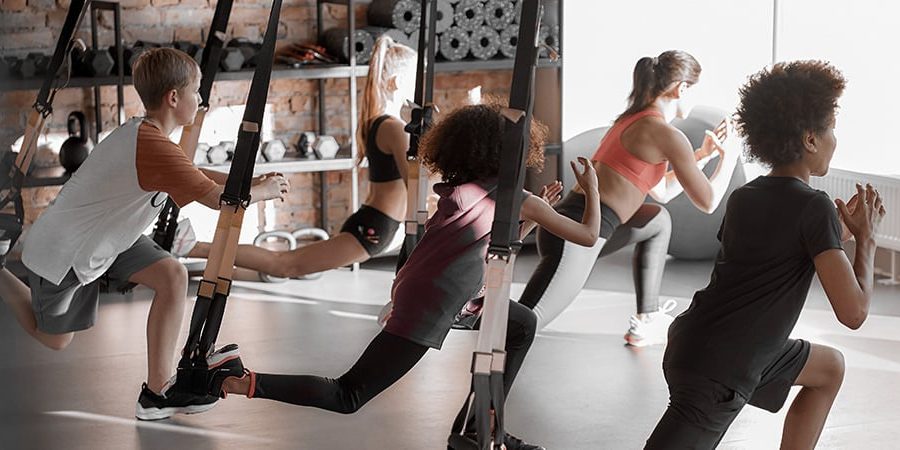Catering to the complicated physiological, developmental, and psychological characteristics of distinct age groups is a fundamental requirement in the area of personal training. Fitness specialists that are well-versed in exercise dynamics throughout the age spectrum recognise the importance of tailored training programmes. This technical discussion digs into the subtle differences in personal training approaches for adults, adolescents, and children, bolstered by factual underpinnings that speak to the discerning fitness practitioner.
Working with Adolescents
Working with adult clients demands a tailored strategy that emphasises cardiovascular fitness, muscular power, flexibility, and body composition management. Congruence with goals and lifestyles is critical in this regard. Seguin et al. (2015) published their findings at https://www.ncbi.nlm.nih.gov/pmc/articles/PMC3727397/. claims that structured exercise regimens significantly reduce chronic diseases in adults. Aerobic exercise and strength training combined provide significant improvements in cardiovascular fitness and adiposity reduction (Kelley et al., 2018). https://bmjopen.bmj.com/content/9/11/e031220. Concurrently, focused flexibility regimes, most notably yoga, give enhanced articular mobility and injury prevention (Cramer et al., 2016). https://pubmed.ncbi.nlm.nih.gov/24146758/.
Adolescents in the Workplace
Personal training complexities in the adolescent demographic rely on a deep understanding of dynamic growth and development patterns. Empirical studies, such as the seminal study by Lloyd et al. (2014) https://bjsm.bmj.com/content/48/7/498 , highlights the critical importance of resistance exercise in optimising bone mineral density and musculoskeletal fortitude. Relevant factors include the acquisition of motor skills and the development of long-term fitness preferences. Integration of structured sports and functional movement patterns appears to reinforce holistic fitness paradigms and social integration (Faigenbaum et al., 2016) https://pubmed.ncbi.nlm.nih.gov/19620931/. Concurrently, it is critical to address body image issues and inculcate positive exercise attitudes (Tremblay et al., 2017). https://bmcpublichealth.biomedcentral.com/articles/10.1186/s12889-018-5903-x.
Working with Kids
Within the context of juvenile personal training, the cautious articulation of play-oriented physical pursuits takes precedence, echoing the ideals advocated by the American College of Sports Medicine (Faigenbaum et al., 2019). Lubans et al. (2016) found that play not only catalyses physiological vitality but also synergistically stimulates cognitive faculties and sociomotor abilities in children. Navigating this population requires carefully calibrating a variety of aspects such as safety, age-appropriate workouts, and the creation of an enticing environment conducive to the perpetuation of a propensity for lifelong physical involvement.

Personal training is a complicated discipline with age-discriminant complexities. Personalised techniques adapted to the needs of adults, adolescents, and children emerge as indispensable, supported by scientific findings. Discerning practitioners expertly balance the demands of physiological quirks, developmental dynamics, and psychological proclivities, resulting in personalised regimens that not only improve physical fitness but also promote overall health across the lifespan.
References
- Seguin, R. A., Heidkamp-Young, E., Kuder, J., Nelson, M. E. (2015). Improved Physical Fitness among Older Female Participants in a nationally Disseminated, Community-Based Exercise Programmesme. Health Education & Behavior, 42(4), 493-499. https://www.ncbi.nlm.nih.gov/pmc/articles/PMC3727397/
- Kelley, G. A., Kelley, K. S., & Tran, Z. V. (2018). Exercise and adiposity in overweight and obese children and adolescents: A systematic review with network meta-analysis of randomised trials. BMJ Open, 8(3), e019073. https://bmjopen.bmj.com/content/9/11/e031220
- Cramer, H., Krucoff, C., Dobos, G. (2016). Adverse Events Associated with Yoga: A Systematic Review of Published Case Reports and Case Series. PLoS ONE, 11(8), e0159925. https://pubmed.ncbi.nlm.nih.gov/24146758/
- Lloyd, R. S., Faigenbaum, A. D., Stone, M. H., et al. (2014). Position statement on youth resistance training: the 2014 International Consensus. British Journal of Sports Medicine, 48(7), 498-505. https://bjsm.bmj.com/content/48/7/498
- Faigenbaum, A. D., Kraemer, W. J., Blimkie, C. J., et al. (2016). Youth resistance training: Updated position statement paper from the National Strength and Conditioning Association. Journal of Strength and Conditioning Research, 23(5 Suppl), S60-S79. https://pubmed.ncbi.nlm.nih.gov/19620931/
- Tremblay, M. S., Costas-Bradstreet, C., Barnes, J. D., et al. (2017). Canada’s Physical Literacy Consensus Statement: Process and Outcome. BMC Public Health, 17(Suppl 5), 799. https://bmcpublichealth.biomedcentral.com/articles/10.1186/s12889-018-5903-x
- Lubans, D. R., Aguiar, E. J., Callister, R. (2016). Active play: An exploratory investigation of associations with long-term physical activity and academic outcomes. Preventive Medicine Reports, 3, 89-92.
Work with Older Adults
Release the potential of exercise for the elderly! If you’re a fitness instructor and want to learn more about working with older clients, this is the course for you. Get a handle on how their bodies work and what drives them so you can create stimulating fitness routines that improve their health, vitality, and overall wellbeing. Learn age-specific training methods, make a real difference, and enter a rising industry by learning how to train the over-50 crowd. Join us now and be a pioneer in the movement to encourage healthy ageing!
Exercise for Older Adults – Distance Study
Course Info
Get Started
Work with Adolescents
With our specialised Exercise for Adolescent Client course, you may enter the unique world of adolescent fitness! This programme is designed exclusively for personal trainers and digs into the developmental intricacies, motivational drives, and physical needs of teenagers. Learn how to design training routines that appeal to youthful energy while meeting their specific physiological and psychological demands. Prepare to inspire the next generation by instilling lifelong exercise habits and cultivating young talent. Enrol today and become a motivator for teens on their fitness journey!
Exercise for Adolescent Clients Course – Distance Study
Course Info
Get Started
